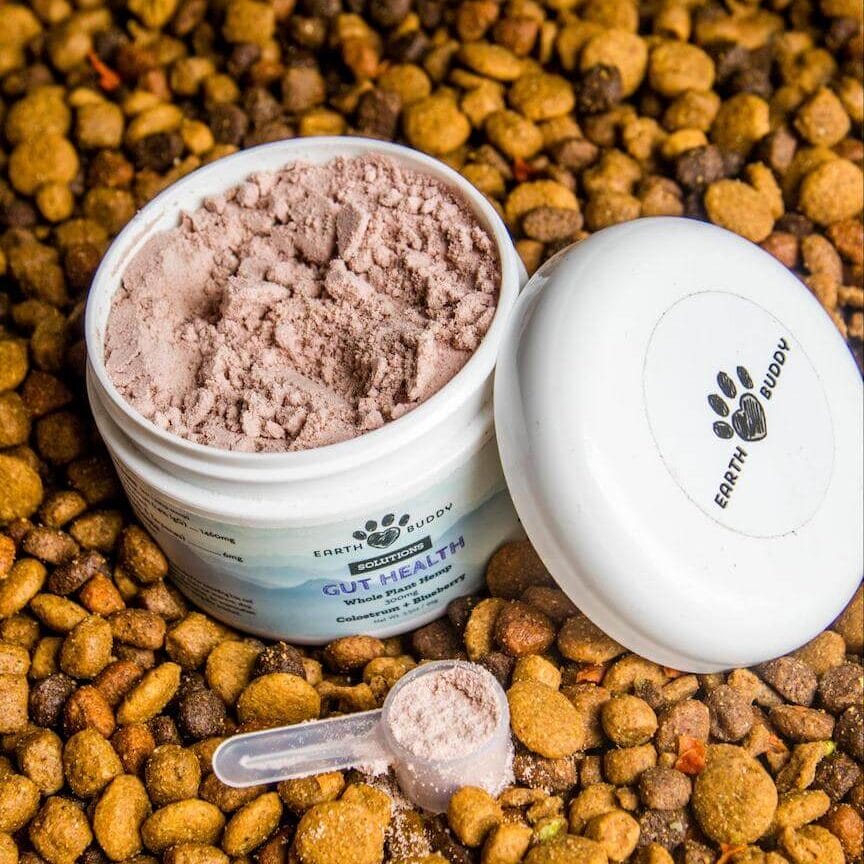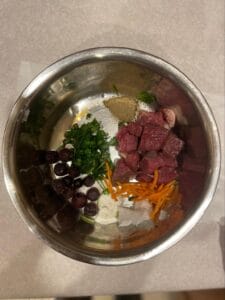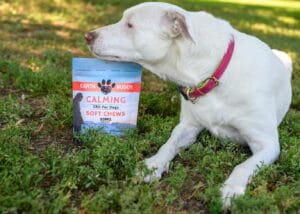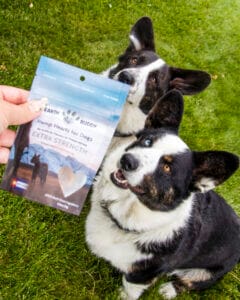
Choosing the right food for your dog is an essential part of responsible pet ownership. By being aware of dog food ingredients to avoid, you can ensure your dog receives the nutrition they need without the risks associated with these additives. Always opt for high-quality, natural ingredients and avoid the ones that aren’t beneficial to your pup in both dry and wet dog food, and even many dog treats.
Dog Food Ingredients to Avoid
Although there is a fairly long list of dog food ingredients to avoid, we’re going to review the most prevalent ones. We recommend spending a few minutes after you read this to do your own research and make sure your dog’s food is high-quality.
Meat and Bone Meal in Dog Food
Meat meal, often listed as an ingredient in dog food, should be approached with caution. The term “meat meal” or similar phrases like “animal fat” are vague and do not specify the exact source or quality of the meat used. This ambiguity can be troubling as it leaves pet owners uncertain about what they are feeding their dogs.
In some dog food brands, a closer look reveals that meat and bone meal can consist of low-quality meat, which might be expired, diseased, or even derived from dead animals.
The use of such unspecified and potentially low-grade meat sources raises concerns about the nutritional adequacy and safety of the dog food. High-quality protein is essential for a dog’s health, and the use of inferior meat meals may lead to nutritional deficiencies or health complications.
The processing of meat meal often involves high temperatures, which can destroy some or perhaps all of the beneficial nutrients it did have. For the well-being of dogs, it’s advisable to choose dog foods that clearly state their meat sources, ensuring transparency and quality.
Artificial Flavors in Dog Food
Artificial flavor enhancers are commonly used in dog food to improve its taste, but they come with downsides. These synthetic additives don’t provide any nutritional benefits. Instead of relying on these artificial enhancers, choose dog foods that derive their flavors from natural, wholesome ingredients to promote and support long term health.
Natural ingredients not only enhance the flavor of dog food in a safer way but also add essential nutrients to a dog’s diet. Quality dog foods flavored with real high-quality meats, vegetables, and fruits are not only more palatable to dogs but also often have a scientifically balanced formula rich in vitamins, minerals, amino acids, enzymes and essential fatty acids.
By opting for dog foods with natural flavor sources, pet owners can ensure that their furry friends enjoy their meals while also receiving the nutritional advantages that these ingredients provide.
Rendered Fat in Pet Foods
Rendered fat in dog food is a contentious ingredient due to several health concerns. Primarily, rendered fat is a vague term that often refers to a mix of animal fats from various, sometimes questionable, sources. This lack of specificity about the origin of the fats can also raise concerns. And, rendered fats are processed at high temperatures, which can lead to the alteration or destruction of beneficial nutrients.
This processing also increases the risk of contamination with harmful bacteria like Salmonella, posing a health risk not just to pets but also to their human owners. Rendered fats can contain high levels of toxins and heavy metals accumulated from the original animal tissues. These factors combined make rendered fat a less desirable ingredient in dog food, as it can compromise the nutritional integrity and safety of the food your pet consumes.
Opting for dog food with clearly identified and high-quality fat sources helps keep animals in peak condition. Fatty acids are vital to everyday health, the heart and cardiovascular systems.
Corn Syrup and Food Dyes to Avoid in Dog Food
Food dyes and corn syrup in dog food are a cause for concern and should generally be avoided. These artificial colors are added to make the food more visually appealing to pet owners rather than for any nutritional benefit to the dog. Corn syrup is added for sweetness and appeal, which is also unnecessary.
Some dyes have been linked to behavioral issues and other complications. Dogs, unlike humans, are not concerned with the color of their food, so these additives serve no purpose in enhancing their mealtime experience. Continuous exposure to artificial dyes can also accumulate in the body over time. Steer clear of dyes if you want to support and promote your dog’s long-term health.
Preservatives Pet Parents Should Avoid in Dog Food
Of course, for shelf life, there needs to be preservatives in dog food. But, in an effort to have a higher profit margin, some pet food companies have incorporated preservatives that could have a negative impact.
Preservatives to avoid include:
- BHA (butylated hydroxyanisole)
- BHT (butylated hydroxytoluene)
- Ethoxyquin
- Nitrates/Nitrites
- Propyl Gallate
- Carrageenan
- MSG
- Sodium Hexametaphosphate
Natural preservatives, such as tocopherols (vitamin E), citric acid, and rosemary extract, are safer alternatives that can effectively maintain food quality. Choosing dog food brands that prioritize the use of natural preservatives not only ensures the safety of the food but also contributes to enhancing the physical and mental well-being of dogs.
It’s advisable to read dog food labels carefully and opt for products that avoid harmful chemical preservatives. The rule of thumb is if you can’t read it or say it out loud, it’s wise to move on to the next bag of food. Then, examine that dog food label to see what’s inside. Don’t forget to look at your dog’s food label at home, too.
Melamine in Dog Food
Melamine is a chemical compound often used in the production of plastics, adhesives, and countertops, but it has no place in dog food due to its toxicity. Despite this, there have been instances where melamine has been illicitly added to dog food in the pet food industry. The reason for this unethical practice is that melamine artificially inflates the protein content in food products when measured with standard protein tests, owing to its high nitrogen content.
This makes the food appear more protein-rich than it actually is. However, the ingestion of melamine can be extremely dangerous for dogs. Melamine’s presence in pet food is a significant concern as it does not offer any nutritional benefit and poses a high risk to a dog’s health.
Pet parents should be vigilant and choose dog foods that are transparent about their ingredients and adhere to strict quality control standards to support the safety and well-being of their pets.
Pet Parents Beware of Vegetable Oil
It’s important to understand the role of fatty acids in a dog’s diet. Both omega-6 and omega-3 fatty acids are crucial, but they need to be in the right balance. Omega-3 fatty acids, often found in fish oils, are known to promote normal inflammatory pathways and can help counteract the effects of omega-6 fatty acids.
To help maintain healthy bone and joint function, it’s beneficial to look for dog foods or supplements that have a higher concentration of omega-3s relative to omega-6s.
Dog Food Ingredients To Look For
When selecting dog food, it’s important to look for ingredients that provide balanced nutrition for your canine companion. Here are some key ingredients that promote and support long term health in most dogs:
- High-quality protein sources: Look for dog foods that list specific, high-quality protein sources as their primary ingredients. These can include named meats like chicken, beef, lamb, fish, or duck. Avoid vague terms like “meat meal” or “animal by-products.”
- Whole vegetables and fruits: Fresh, whole fruits and vegetables provide essential vitamins, minerals, and fiber. They can include carrots, peas, sweet potatoes, apples, and blueberries.
- Healthy fats: Good sources of fats are vital to help support your dog’s coat and skin health. Look for ingredients like flaxseed, fish oil, or chicken fat, which provide essential fatty acids like omega-3 and omega-6. Omega-3 fatty acids help decrease normal inflammatory pathways which may also help with occasional stiffness and soreness.
- Complex carbohydrates: Whole grains or grain-free carbohydrate sources such as brown rice, barley, oats, or sweet potatoes support energy production and are easier to digest.
- Vitamins and minerals: A balanced dog food should contain a range of vitamins and minerals. Sometimes these are included as whole food ingredients, and other times they are added as supplements.
- Natural preservatives: Natural preservatives like vitamin C (ascorbic acid), vitamin E (mixed tocopherols), and rosemary extract are safer than chemical preservatives.
- Probiotics: Probiotics balance the animal’s intestinal microflora which assist in the digestion and absorption of nutrients. Some dog foods include added probiotics to help support proper digestion and bowel health.
- No fillers, artificial colors, or flavors: Avoid dog foods with unnecessary fillers (like corn and soy), artificial colors, and artificial flavor enhancers, as they don’t provide nutritional value and can be harmful.
Remember, the best food for your dog can depend on their age, breed, activity level, and any specific health needs. It’s always a good idea to consult with your veterinarian to determine the most appropriate diet for your dog.
Limited Ingredient Dog Treats
When it comes to choosing dog treats, opting for those with limited ingredients is usually a smart choice. Earth Buddy provides CBD soft chews that prioritize real meat as the primary ingredient. Free from artificial flavors and preservatives, these treats are both healthy and appealing. They’re available in two tasty options, each with a different dosage of full spectrum hemp extract. You can select either the Duck & Apple Soft Chews, containing 5mg of CBD per chew, or the Beef & Pumpkin Soft Chews, which offer 10mg of CBD in each chew.
For further reading, we recommend:
- https://www.ncbi.nlm.nih.gov/pmc/articles/PMC4745505/
- https://www.ncbi.nlm.nih.gov/pmc/articles/PMC9219525/
- https://truthaboutpetfood.com/the-disgusting-truth-of-rendered-pet-food-ingredients/
- https://truthaboutpetfood.com/what-are-meat-meal-ingredients/
- https://pubmed.ncbi.nlm.nih.gov/23026007/#:~:text=Red%203%20causes%20cancer%20in,Yellow%206
- https://ehjournal.biomedcentral.com/articles/10.1186/s12940-022-00849-9
- https://www.sciencedirect.com/science/article/abs/pii/S0269749118303075
You Might Also Enjoy
Reactive dog barking may sound intimidating, but it’s important to differentiate it from dog aggression.…
Your dog’s skin is their largest organ making dog skin care a crucial part of…
Like us, our dogs, and other mammalian species, cats have an endocannabinoid system. This system…






